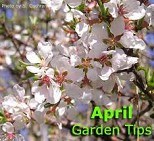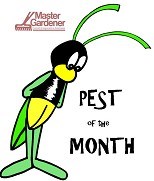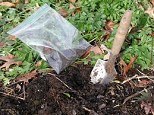Posted 4/11/2013

It's easy to lure butterflies to your yard by planting a few of their favorite flowers. You can even create a complete habitat that attracts a delightful array of winged diners with a bit of planning.
What to include in your plan:
Attract butterflies to your garden with a wide variety of plants. Now's the time to make a plan for a spring project, whether it's a new garden to welcome butterflies in every stage of their development, or add or enhance an existing garden. Your plan should provide spots for sunning and laying eggs, host plants for hungry caterpillars, shallow water sources, and a safe harbor when the time comes for metamorphosis.
Choose a Sunny Spot:
Most flowers that attract butterflies require at least six hours of sunlight each day. It's also helpful to create your butterfly garden in a spot that's sheltered from the wind. Check out a butterfly's tissue-paper-thin wings and you'll see why they appreciate protection.Tip: You may see butterfly houses for sale. These are merely garden ornaments; butterflies don't usually take shelter in them
Include Children:
Not much hooks a little boy or girl's interest in gardening more quickly than a colorful butterfly in flight. Appreciation for plants will follow closely on the heels of chasing butterflies on paths through wild tangles of blooms as tall as the tops of the kids' heads.Tip: Get kids even more involved when they can watch all the stages of a butterfly's life cycle. To learn more about planning a butterfly garden view the whole article below.
Posted 4/11/2013

No matter if you are planning a new country cottage garden or a more formal style garden there are some basic gardening techniques that will help you reduce your maintenance chores.
1. Start small and start with a plan. Keep your garden small, and most of all, fun. Look at pictures of the style garden you like and try to put those elements into your garden. Over time, as your confidence grows, increase the size.
2. Invest in soil. Starting with good, rich, organic soil where plants will thrive with a minimum of watering and fertilizing cuts the work from the start. We always recommend doing a soil test to learn about the type of soil you have. Add organic matter yearly, either by purchasing compost or making your own.
3. Position plants carefully. Much of the work in a garden comes from not having the right plant in the right place. The healthiest plants, ones that need less care, are those that are placed in ideal conditions. I suggest you read the tags on the plants you buy and if your new garden bed is in the sun, look for plants that love the sun, if it's shady look for that on the tag or signage, too. I also like to see what other gardens in my neighborhood have. Chances are if plants do well locally they will do well in your garden/zone.
4. Select sturdy plants. Choose high-impact plants. There's no absolutely right or wrong way to create a garden, so choose what you love. Some favorite easy to grow perennial plants include spring-flowering bulbs, purple coneflower (Echinacea purpurea), indigo (Baptisia australis), 'Stella d'Oro' or 'Happy Returns' daylily (Hemerocallis), New England aster (Aster novae-angliae 'Alma Potschke'), and Russian sage (Perovskia atriplicifolia 'Blue Spire').
For foliage interest, try lady's mantle (Alchemilla mollis), lambs' ears (Stachys byzantina 'Helene Von Stein'), or blue fescue (Festuca glauca). To avoid high-maintenance roses, you can try growing tough, disease-resistant Knock Out shrub roses, Meidiland landscape roses or 'Betty Prior' (a floribunda rose). You'll need plenty of sun for roses, 6 hours a day is considered a sunny garden.
Plant some annuals for summer long color. You can't beat a few annuals tucked into your new flower garden to add long lasting color. Annuals are the work horses of the flower world!
5. Mulch Mulch Mulch. Mulching helps maintain soil moisture levels and prevents weeds from growing.. Mulching can save up to 30% water use compared to bare soil! As organic mulch (bark, compost, or leaf mold) breaks down, it improves soil. Mulch also can give the garden a neater, more unified look.
6. Easy watering. I like drip hoses, as it's easy to put the water exactly where you want it, not on the foliage or flowers. It's also more environmentally correct since less water evaporates into the air. If you want to fully automate your watering there are lots of interesting soil moisture sensors and or timers so your chores can be even further reduced.
Going out in you yard to observe and spend time in your garden is a rewarding experience, enjoy a bit of nature and the beautiful spring season with less work and more fun!
Posted 3/12/2013
by Phyllis Minich

Pruning your trees can help encourage healthy growth and maintain the desired structure you want. To prevent harm when cutting branches thicker than 1 inch, you should use the 3-cut method:
1. First cut the selected limb 4 to 6 inches above the location of where you want the final cut to be. (This distance will vary depending on how large the limb is.) Make a half-inch cut into the underside of the branch.
2. Around two inches farther out from your first cut, slice through the branch. The first cut acts as a stopping point, helping to prevent damage to the tree from possible breaking/ripping that may occur from the heaviness of the falling limb. Now there is only a short limb remaining.
3. This final cut is the most crucial. Locate the "collar", or the junction where the limb meets the trunk and cut about a quarter inch away from the collar. The tissue left within this area will help your tree heal.
With this three-step pruning method, you can help ensure your tree stays healthy and strong.
Posted 3/5/2013
by Frank Rossi

It’s a sure sign of spring: the robins return and millions of lawn owners head out to apply fertilizer and weed-killers to their lawns – a rite widely known as ‘weed and feed’.
But here’s the problem: early spring probably isn’t the best time for you to fertilize your grass or apply herbicides unless you have a history of weed problems.
Let’s start with the herbicides. Weed and feed products designed for early-spring application usually contain pre-emergent herbicides. They work by preventing weed seeds from sprouting and they can be an effective way to control crabgrass and some broadleaf weeds.
Trouble is, this assumes that you’ve got weed seeds in your soil ready to sprout. If you’ve been using pre-emergent herbicides regularly or otherwise doing a good job of controlling weeds and keeping them from going to seed, you may have exhausted the supply of weed seeds in the soil. If that’s the case, applying pre-emergent herbicides is like clapping your hands to keep the lions away.
Then there’s the fertilizer. It should be mostly nitrogen and I’ll admit that it can really green up the grass in a hurry. But it can also fuel lush top growth at the expense of roots and you want those roots going deep for moisture so the grass can outcompete weeds during the hot, dry summer months to come. That lush top growth also means you’ll need to mow more often and deal with more clippings.
If you’re going to apply fertilizer, Memorial Day and Labor Day are better times to do it and with recent restrictions on phosphorus fertilizer in many areas and the lack of evidence that potassium will improve your lawn in most circumstances, shop around for fertilizers that are all nitrogen. To view the entire article about fertilizing click below.
Posted 3/5/2013
“Liming and fertilizing without a soil test is like building a home without a blueprint”.
Fertilizer and lime are most effect when used in proper amounts. Soil tests provide a scientific basis for correct usage. If you fail to follow the recommendations you cannot expect to get top yields and returns.
For most situations (lawn, vegetable garden ornamentals, etc.) the soil should be sampled every two to three years. For situations involving high-value cash crops or soils under intensive use, it is recommended that the soil be tested prior to planting the crop.
Soil samples may be taken at any time during the year, however, avoid extremely wet soil conditions unless absolutely necessary. It is recommended that successive samples from a given situation be taken at about the same time of the year.
- Use a garden spade or shovel and slice into the soil to a depth of six inches.
- Take a once inch thick slice of soil from the side of the hole. Repeat this process to obtain five to ten samples, randomly taken, depending on the size of your lawn or garden.
- Combine all samples into a clean container and mix thoroughly, removing any plant debris or stone. A half to one cup of soil is all that is needed for testing.
- If your soil is wet, you will need to let it dry. Let it dry naturally. DO NOT dry in a conventional or microwave oven.
- Label samples for proper identification (e.g. back lawn, vegetable garden). Include your name, address and daytime phone number.
Samples can be brought to Cornell Cooperative Extension office in Canajoharie for testing. There is a $2.00 fee per sample for pH testing.
If a more complex testing of soil nutrients is desired, Cornell University has contracted with Agro-One Services to do soil analysis. Contact them at www.dairyone.com.
Posted 2/21/2013
by Barbara Henry

Now is a good time to take a look at pruning shrubs but be careful to note when is the best to do this. Pruning at the wrong time for the plant can destroy the flowers for the year. In general one should prune spring blooming shrubs (lilacs, forsythia, weigela, viburnun for example) right after they bloom. It is the summer blooming shrubs that can be pruned now because they bloom on new growth so the more they are pruned now the better flower production there will be in the summer. There are a couple of choices on how you treat shrubs, the first is to do a maintenance pruning which involves removing any dead material and any branches that cross each other and remove the small branches of less than a pencil width. After that, take a look at the shrub and cut back any lanky growth that interferes with the shrub’s natural shape and shorten up the tips of the branches to encourage new growth. Pruning this way will give you shrubs that increase in size each year with fruit and blooms appearing on the new wood.
If you have an old shrub or one that has become too big for its space in which case one should think about doing a more drastic pruning. To learn more about how to drastically prune and when is the ideal time to prune view the entire article below.
Posted 2/13/2013
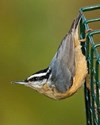
For the first time, anyone anywhere in the world with Internet access can participate in the 16th annual Great Backyard Bird Count (GBBC) February 15-18. Participants simply watch birds at any location for at least 15 minutes, tally the numbers of each species they see, and report their tallies online at www.BirdCount.org. The GBBC is a joint project of the Cornell Lab of Ornithology and Audubon, with Canadian partner Bird Studies Canada.
This year, anyone visiting the GBBC website will be able to see bird observations pouring in from around the world and contribute their own tallies. Global participation will be made possible thanks to eBird, a real-time online checklist program that the Cornell Lab and Audubon are integrating into the GBBC for the first time this year. The GBBC is open to anyone of any skill level and welcomes bird observations from any location, including backyards, national parks, gardens, wetlands, and urban landscapes. The four-day count typically receives sightings from tens of thousands of people reporting more than 600 bird species in the United States and Canada alone.
"We're eager to see how many of the world's 10,240 bird species will be reported during the count this year," said Cornell Lab director John Fitzpatrick. "We're looking forward to this historic snapshot of birds that that will be reported from around the world. We need as many people as possible to help build the wealth of data that scientists need to track the health of bird populations through time."
Participants will be able to view what others are seeing on interactive maps and contribute their tallies for ongoing bird research and conservation efforts. For the first time, participants will also be able to upload their counts from the field using the eBird BirdLog app for Apple or Android smartphones. To celebrate the new global reach of the count, developers of the eBird BirdLog app are offering regional versions of the app for just 99 cents through February 18. For more information about this great event visit http://www.birdsource.org/gbbc or view the document below.
Posted 2/6/2013
by Phyllis Minich
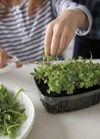
Want to add a bit of beauty and freshness to your home this winter? And eat it, too? Well there are many options available now. One of my favorite ideas is growing a windowsill garden of micro-greens and herbs for salads. Micro-greens sound unusual but it’s really just seeds usually used for sprouts grown in soilless mix. You can recycle your berry containers from the grocery store into mini planters, too. They function well because of the many openings, which allows for good drainage. When sprouting any seed keeping the soil moist is important but you never want to ‘drown’ the seeds because of poor drainage.
So here’s the technique; you’ll need a sunny window sill, protecting it with a saucer will be good for the sill! Next if you don’t have any potting mix left from your summer container garden projects, buy a small fresh bag at the hardware store. It will serve you well not to use garden soil since it can have bugs overwintering in it and is more prone to compaction in a pot. Not to mention it’s probably frozen solid right now. Fill your containers ¾ full of soil. Sprinkle the seeds of choice on top and sprinkle a small amount of fine soil over them, press lightly on the soil. If you are using larger seeds like sunflower (which do make good greens) sprinkle a bit more soil over them and then press the soil lightly to insure contact. Water thoroughly but don’t run a heavy stream from the faucet or you’ll dislodge the seed bed you’ve just created. I like to water from the bottom by placing the new container in a pot with a bit of water in it placed in the sink, especially at first to get the soil hydrated and then use a sprayer, I always have one in the house for house plants. You can repurpose a glass cleaner bottle that’s been rinsed well. I always rinse the seeds before I plant them just to be sure they’re clean. Always buy organic seed designated for sprouting, otherwise they could be treated with any manner of chemicals. Cut the seedlings just above the soil line when harvesting. Would you like to know what seeds work best for indoor gardens then view the entire article below.
Posted 2/6/2013

The answer is that some (but not all) types of hydrangea set their flower buds in the fall, so they "bloom on old wood". The buds begin to emerge with the first warm spring weather, then when they are subjected to a late frost, the buds are damaged and flowering is minimal. The group of hydrangea at peril are the Hydrangea macrophyllas such as 'Nikko Blue' and 'Tokyo Delight'. Hydrangea macrophyllas, aka Bigleaf hydrangea have large thick, often heart-shaped green leaves. Their flowers may be round balls (mopheads) or lacecaps, which are flat in the center surrounded by a ring of petals. Flower color ranges from shades of blue, pink and purple and hydrangeas like full morning sun and afternoon shade.
Hydrangeas that bloom on old wood will not flower if you cut down your bush in winter. You will have cut off all the old wood with flower buds set.
You can help protect emerging buds from spring frosts with an anti-dessicant spray. Apply the spray in late winter/early spring. Don't forget to check the label to see when the spray may need to be repeated.
If you have lush foliage with no blooms it can also mean that there is too much nitrogen fertilizer combined with too much water. Consider using a single application of an organic fertilizer in the spring.
In recent years, growers have developed new varieties which bloom on both new and old growth, so the new spring developed buds will bloom even if those set in fall are damaged.
Posted 1/23/2013
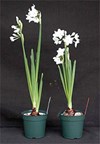
The paperwhite narcissus is a popular bulb for indoor forcing in the winter months. Unlike most other daffodils, paperwhites (Narcissus tazetta) do not require a cold period. They are simply planted in pots with soil, or even more commonly, in dishes or bowls with gravel, marbles or other decorative material. With a little water, they rapidly form roots, grow leaves and shoots. The white, fragrant flowers usually open up within 2-3 weeks of planting.
A common problem with paperwhites, however, is that they often grow too tall and flop over. Recent research conducted by the Flowerbulb Research Program at Cornell University has found a simple and effective way to reduce stem and leaf growth of paperwhites. The “secret” is using dilute solutions of alcohol. Properly used, the result is paperwhites that are 1/3 to ½ shorter, with equal sized flowers that last as long as normal.












